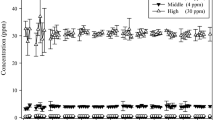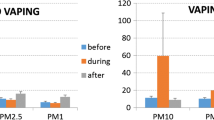Abstract
When ethylene oxide or butadiene monoxide is added to the atmosphere of a closed inhalation chamber occupied by Sprague-Dawley rats, a first-order elimination pattern is observed. When either of these compounds is IP injected into rats which are subsequently placed in the closed chamber, the course of epoxide in the atmosphere follows Bateman exponential functions.
From the experimental data, the kinetic parameters for distribution and metabolic elimination of ethylene oxide and butadiene monoxide can be derived.
When ethylene or 1,3-butadiene was added to the closed exposure systems and kept at atmospheric concentrations which assured maximal metabolic turnover of the olefin (i.e., concentrations above 1,000 ppm ethylene or 1,500 ppm 1,3-butadiene), exhalation of the appropriate epoxide occurred and led finally to a constant (plateau) concentration of the reactive metabolite in the system's atmosphere. Although the initial time-course was different between butadiene monoxide and ethylene oxide (with a high initial increase of ethylene oxide and a subsequent decrease) an analysis at steady-state (plateau concentrations) revealed that only 29% of the amounts of both epoxides which in theory are formed as primary metabolites from the parent olefins are systematically available (i.e., distributed in the entire organism). The discrepancy is probably related to first pass elimination of the epoxide.
Similar content being viewed by others
References
Altman PL, Dittmer DS (1964) Biology Data Book, Vol 3, Federation of American Societies for Experimental Biology, Washington, p 1990
Andersen ME, Thomas OE, Gargas ML, Jones RA, Jenkins LJ (1980) The significance of multiple detoxification pathways for reactive metabolites in the toxicity of 1,1,-dichloroethylene. Toxicol Appl Pharmacol 52: 422–432
Appelgren LE, Eneroth G, Grant C, Landström LE, Tenhagen K (1978) Testing of ethylene oxide for mutagenicity using the micronucleus test in mice and rats. Acta Pharmacol Toxicol 43: 69–71
Bolt HM, Filser JG (1984) Olefinic hydrocarbons: a first risk estimate for ethene. Toxicologic Pathology 12: 101–105
Bolt HM, Schmiedel G, Filser JG, Rolzhäuser HP, Lieser K, Wistuba D, Schurig V (1983) Biological activation of 1,3-butadiene to vinyl oxirane by rat liver microsomes and expiration of the reactive metabolite by exposed rats. J Cancer Res Clin Oncol 106: 112–116
Bolt HM, Filser JG, Störmer F (1984) Inhalation pharmacokinetics based on gas uptake studies. V. Comparative pharmacokinetics of ethylene and 1,3-butadiene in rats. Arch Toxicol 55: 213–218
Brooks P, Lawley PD (1961) The alkylation of guanosine and guanylic acid. J Chem Soc, p 3923ff
Citti L, Gervasi PG, Turdu G, Bellucci G, Bianchini R (1984) The reaction of 3,4-epoxy-1-butene with deoxyguanosine and DNA in vitro: synthesis and characterization of the main adducts. Carcinogenesis 5: 47–52
Darby TD, Martis L, Northup SJ (1980) Pharmacokinetic aspects of worker exposure. In: The safe use of EO; Proceedings of the Educational Seminar, Chapter 1. Jorkasky JF, ed. Health Industry Manufacturers Association, Washington, DC, HIMA Report No. 80-4
Deutsche Forschungsgemeinschaft (1983) 1,3-Butadien. In: Toxikologisch-arbeitsmedizinische Begründungen von MAK-Werten. Henschler D, ed, 9. Lieferung, Verlag Chemie, Weinheim, FRG
ECETOC (1982) Technical report No. 5. Toxicity of ethylene oxide and its relevance to man. European Chemical Industry Ecology & Toxicology Centre, Ave. Louise 250, Bruxelles
Ehrenberg L, Hiesche KD, Osterman-Golkar S, Wennberg J (1974) Evaluation of genetic risks of alkylating agents. Tissue doses in the mouse from air contaminated with ethylene oxide. Mutat Res 24: 83–103
Ehrenberg L, Osterman-Golkar S, Segerbäck D, Svensson K, Calleman CJ (1977) Evaluation of genetic risks of alkylating agents. III. Alkylation of hemoglobin after metabolic conversion of ethene to ethene oxide in vivo. Mutat Res 45: 175–184
Filser JG, Bolt HM (1979) Pharmacokinetics of halogenated ethylenes in rats. Arch Toxicol 42: 123–136
Filser JG, Bolt HM (1981) Inhalation pharmacokinetics based on gas uptake studies. I. Improvement of kinetic models. Arch Toxicol 47: 279–292
Filser JG, Bolt HM (1983a) Exhalation of ethylene oxide by rats on exposure to ethylene. Mutat Res 120: 57–60
Filser JG, Bolt HM (1983b) Inhalation pharmacokinetics based on gas uptake studies IV. The endogenous production of volatile compounds. Arch Toxicol 52: 123–133
Filser JG, Bolt HM, Muliawan H, Kappus H (1983) Quantitative evaluation of ethane and n-pentane as indicators of lipid peroxidation in vivo. Arch Toxicol 52: 135–147
Jones AR, Wells G (1981) The comparative metabolism of 2-bromoethanol and ethylene oxide in the rat. Xenobiotica 11: 763–770
Loew GH, Kurkjian E, Rebagliati M (1983) Metabolism and relative carcinogenic potency of chloroethylenes: a quantum chemical structure-activity study. Chem-Biol Interact 43: 33–66
Malvoisin E, Lhoest G, Poncelet F, Roberfroid M, Mercier M (1979) Identification and quantitation of 1,2-epoxybutene-3 as the primary metabolite of 1,3-butadiene. J Chromatogr 178: 419–425
Malvoisin E, Mercier M, Roberfroid M (1982) Enzymatic hydration of butadiene monoxide and its importance in the metabolism of butadiene. In: Snyder R, Parke DV, Kocsis JJ, Jollow DJ, Gibson CG, Witmer CM (eds) Biological reactive intermediates II, Part A, Plenum Publ Co, New York, pp 437–444
Malvoisin E, Roberfroid M (1982) Hepatic microsomal metabolism of 1,3-butadiene. Xenobiotica 12: 137–144
Schmiedel G, Filser JG, Bolt HM (1983) Rat liver microsomal transformation of ethene to oxirane in vitro. Toxicol Lett 19: 293–297
Segerbäck D (1983) Alkylation of DNA and hemoglobin in the mouse following exposure to ethene and ethene oxide. Chem Biol Interact 45: 139–152
Author information
Authors and Affiliations
Rights and permissions
About this article
Cite this article
Filser, J.G., Bolt, H.M. Inhalation pharmacokinetics based on gas uptake studies. Arch Toxicol 55, 219–223 (1984). https://doi.org/10.1007/BF00341014
Received:
Accepted:
Issue Date:
DOI: https://doi.org/10.1007/BF00341014




